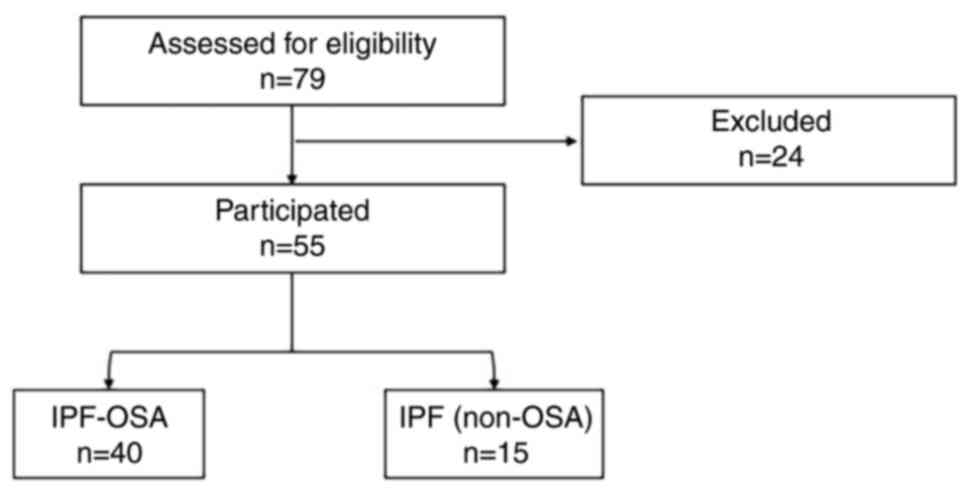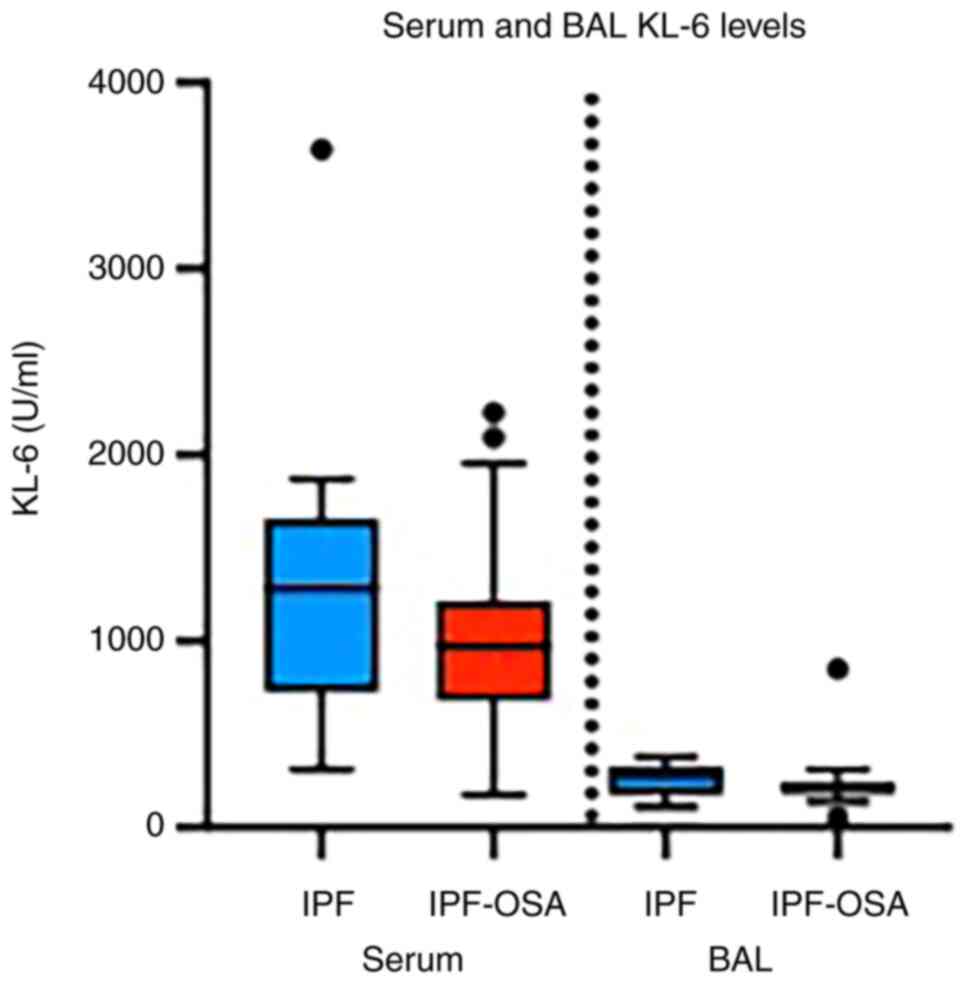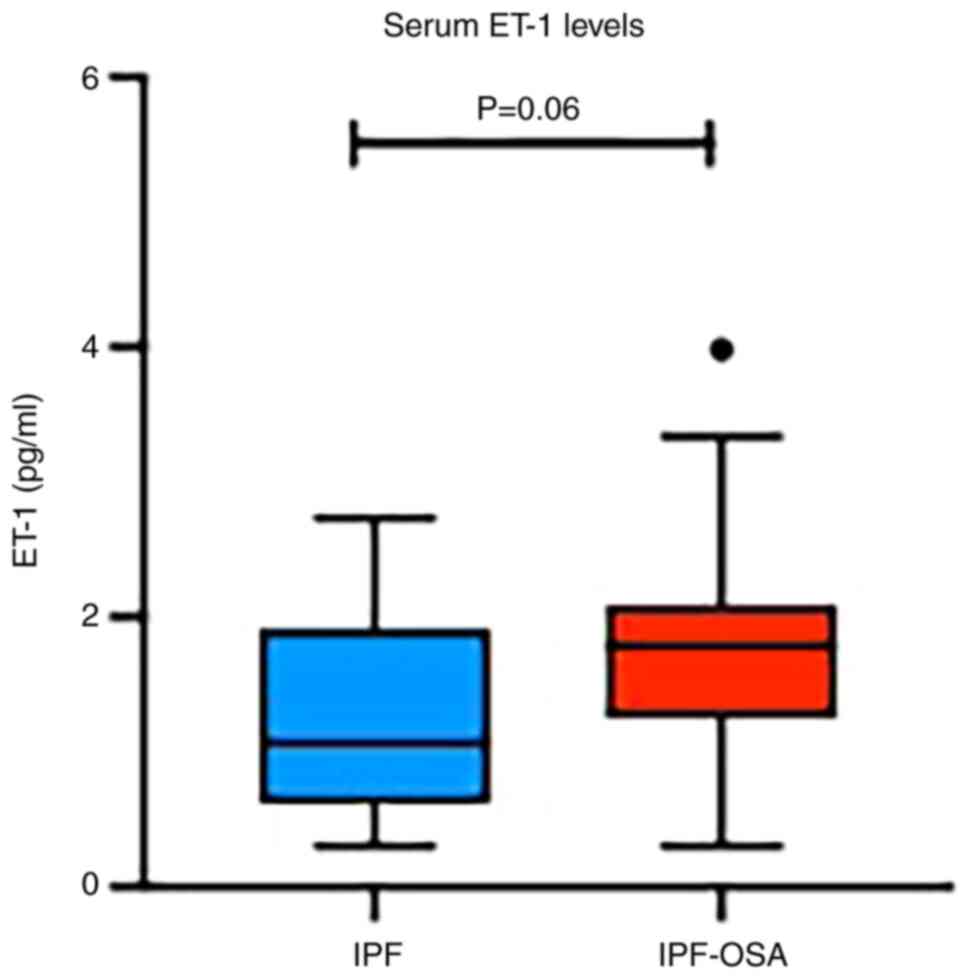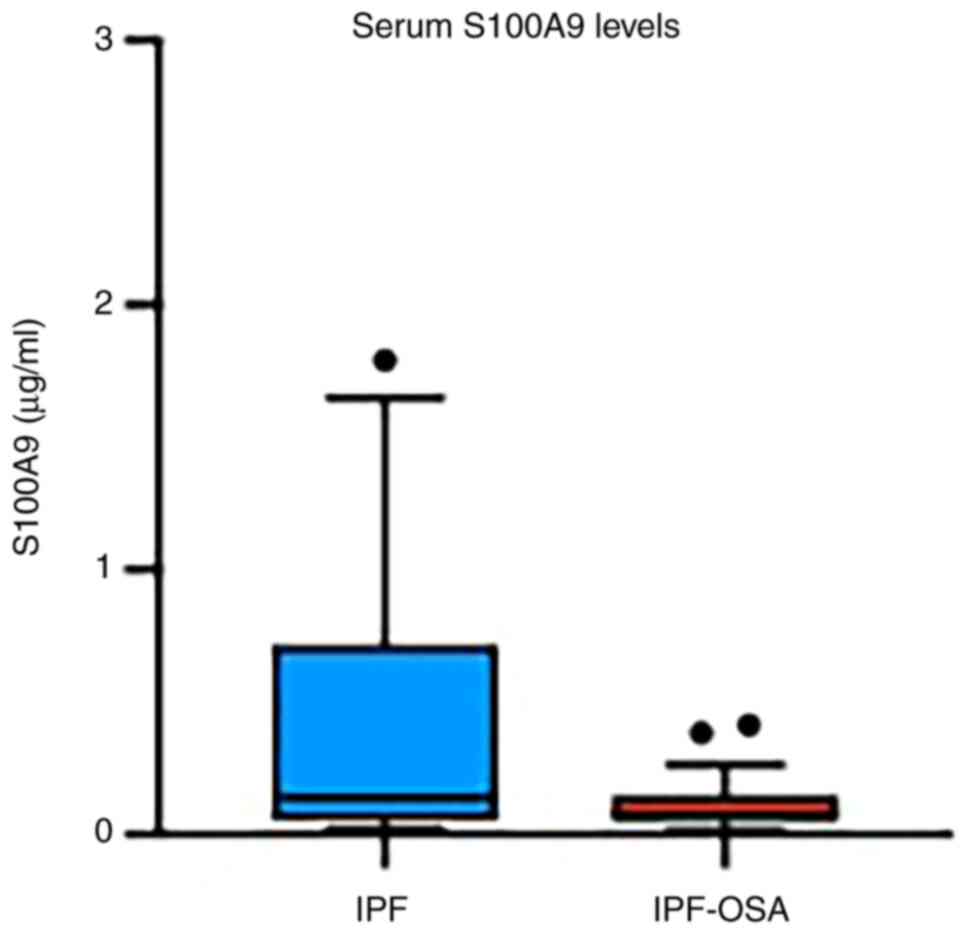|
1
|
Raghu G, Remy-Jardin M, Myers JL, Richeldi
L, Ryerson CJ, Lederer DJ, Behr J, Cottin V, Danoff SK, Morell F,
et al: Diagnosis of idiopathic pulmonary fibrosis. An official
ATS/ERS/JRS/ALAT clinical practice guideline. Am J Respir Crit Care
Med. 198:e44–e68. 2018.PubMed/NCBI View Article : Google Scholar
|
|
2
|
Raghu G, Remy-Jardin M, Richeldi L,
Thomson CC, Inoue Y, Johkoh T, Kreuter M, Lynch DA, Maher TM,
Martinez FJ, et al: Idiopathic pulmonary fibrosis (an Update) and
progressive pulmonary fibrosis in adults: An official
ATS/ERS/JRS/ALAT clinical practice guideline. Am J Respir Crit Care
Med. 205:e18–e47. 2022.PubMed/NCBI View Article : Google Scholar
|
|
3
|
Cano-Jiménez E, Hernández González F and
Peloche GB: Comorbidities and complications in idiopathic pulmonary
fibrosis. Med Sci (Basel). 6(71)2018.PubMed/NCBI View Article : Google Scholar
|
|
4
|
Margaritopoulos GA, Antoniou KM and Wells
AU: Comorbidities in interstitial lung diseases. Eur Respir Rev.
26(160027)2017.PubMed/NCBI View Article : Google Scholar
|
|
5
|
Mermigkis C, Bouloukaki I, Antoniou K,
Papadogiannis G, Giannarakis I, Varouchakis G, Siafakas N and
Schiza SE: Obstructive sleep apnea should be treated in patients
with idiopathic pulmonary fibrosis. Sleep Breath. 19:385–391.
2015.PubMed/NCBI View Article : Google Scholar
|
|
6
|
Mermigkis C, Stagaki E, Tryfon S, Schiza
S, Amfilochiou A, Polychronopoulos V, Panagou P, Galanis N,
Kallianos A, Mermigkis D, et al: How common is sleep-disordered
breathing in patients with idiopathic pulmonary fibrosis? Sleep
Breath. 14:387–390. 2010.PubMed/NCBI View Article : Google Scholar
|
|
7
|
Lancaster LH, Mason WR, Parnell JA, Rice
TW, Loyd JE, Milstone AP, Collard HR and Malow BA: Obstructive
sleep apnea is common in idiopathic pulmonary fibrosis. Chest.
136:772–778. 2009.PubMed/NCBI View Article : Google Scholar
|
|
8
|
Karuga FF, Kaczmarski P, Szmyd B,
Białasiewicz P, Sochal M and Gabryelska A: The association between
idiopathic pulmonary fibrosis and obstructive sleep apnea: A
systematic review and meta-analysis. J Clin Med.
11(5008)2022.PubMed/NCBI View Article : Google Scholar
|
|
9
|
Xie W, Zheng F and Song X: Obstructive
sleep apnea and serious adverse outcomes in patients with
cardiovascular or cerebrovascular disease: A PRISMA-compliant
systematic review and meta-analysis. Medicine (Baltimore).
93(e336)2014.PubMed/NCBI View Article : Google Scholar
|
|
10
|
Shahar E, Whitney CW, Redline S, Lee ET,
Newman AB, Nieto FJ, O'Connor GT, Boland LL, Schwartz JE and Samet
JM: Sleep-disordered breathing and cardiovascular disease:
Cross-sectional results of the sleep heart health study. Am J
Respir Crit Care Med. 163:19–25. 2001.PubMed/NCBI View Article : Google Scholar
|
|
11
|
Gami AS, Howard DE, Olson EJ and Somers
VK: Day-night pattern of sudden death in obstructive sleep apnea. N
Engl J Med. 352:1206–1214. 2005.PubMed/NCBI View Article : Google Scholar
|
|
12
|
Bosi M, Milioli G, Fanfulla F, Tomassetti
S, Ryu JH, Parrino L, Riccardi S, Melpignano A, Vaudano AE,
Ravaglia C, et al: OSA and prolonged oxygen desaturation during
sleep are strong predictors of poor outcome in IPF. Lung.
195:643–651. 2017.PubMed/NCBI View Article : Google Scholar
|
|
13
|
Lee JH, Jang JH, Park JH, Lee S, Kim JY,
Ko J, Jung SY, Kim DW, Hong S and Jang HJ: Prevalence and clinical
impacts of obstructive sleep apnea in patients with idiopathic
pulmonary fibrosis: A single-center, retrospective study. PLoS One.
18(e0291195)2023.PubMed/NCBI View Article : Google Scholar
|
|
14
|
Gille T, Didier M, Boubaya M, Moya L,
Sutton A, Carton Z, Baran-Marszak F, Sadoun-Danino D, Israël-Biet
D, Cottin V, et al: Obstructive sleep apnoea and related
comorbidities in incident idiopathic pulmonary fibrosis. Eur
Respir. 49(1601934)2017.PubMed/NCBI View Article : Google Scholar
|
|
15
|
Melo NCV, Amorim FF and Santana ANC:
Connecting the dots: Hypoxia, pulmonary fibrosis, obstructive sleep
apnea, and aging. Am J Respir Crit Care Med.
191(966)2015.PubMed/NCBI View Article : Google Scholar
|
|
16
|
Sindhu A, Jadhav U, Ghewade B, Wagh P and
Yadav P: Unveiling the diagnostic potential: A comprehensive review
of bronchoalveolar lavage in interstitial lung disease. Cureus.
16(e52793)2024.PubMed/NCBI View Article : Google Scholar
|
|
17
|
Jee AS, Sahhar J, Youssef P, Bleasel J,
Adelstein S, Nguyen M and Corte TJ: Review: Serum biomarkers in
idiopathic pulmonary fibrosis and systemic sclerosis associated
interstitial lung disease-frontiers and horizons. Pharmacol Ther.
202:40–52. 2019.PubMed/NCBI View Article : Google Scholar
|
|
18
|
Lin L, Zhao Y, Li Z, Li Y, Wang W, Kang J
and Wang Q: Expression of S100A9 and KL-6 in common interstitial
lung diseases. Medicine (Baltimore). 101(e29198)2022.PubMed/NCBI View Article : Google Scholar
|
|
19
|
Ross B, D'Orléans-Juste P and Giaid A:
Potential role of endothelin-1 in pulmonary fibrosis: From the
bench to the clinic. Am J Respir Cell Mol Biol. 42:16–20.
2010.PubMed/NCBI View Article : Google Scholar
|
|
20
|
Graham BL, Steenbruggen I, Miller MR,
Barjaktarevic IZ, Cooper BG, Hall GL, Hallstrand TS, Kaminsky DA,
McCarthy K, McCormack MC, et al: Standardization of spirometry 2019
update. An official American thoracic society and European
respiratory society technical statement. Am J Respir Crit Care Med.
200:e70–e88. 2019.PubMed/NCBI View Article : Google Scholar
|
|
21
|
Macintyre N, Crapo RO, Viegi G, Johnson
DC, van der Grinten CP, Brusasco V, Burgos F, Casaburi R, Coates A,
Enright P, et al: Standardisation of the single-breath
determination of carbon monoxide uptake in the lung. Eur Respir J.
26:720–735. 2005.PubMed/NCBI View Article : Google Scholar
|
|
22
|
Ley B, Ryerson CJ, Vittinghoff E, Ryu JH,
Tomassetti S, Lee JS, Poletti V, Buccioli M, Elicker BM, Jones KD,
et al: A multidimensional index and staging system for idiopathic
pulmonary fibrosis. Ann Intern Med. 156:684–691. 2012.PubMed/NCBI View Article : Google Scholar
|
|
23
|
Johns MW: A new method for measuring
daytime sleepiness: The Epworth sleepiness scale. Sleep.
14:540–545. 1991.PubMed/NCBI View Article : Google Scholar
|
|
24
|
Beck AT, Steer RA and Carbin MG:
Psychometric properties of the beck depression inventory:
Twenty-five years of evaluation. Clin Psychol Rev. 8:77–100.
1988.
|
|
25
|
Martinez TY, Pereira CA, Dos Santos ML,
Ciconelli RM, Guimarães SM and Martinez JAB: Evaluation of the
short-form 36-item questionnaire to measure health-related quality
of life in patients with idiopathic pulmonary fibrosis. Chest.
117:1627–1632. 2000.PubMed/NCBI View Article : Google Scholar
|
|
26
|
Berry RB, Brooks R, Gamaldo C, Harding SM,
Lloyd RM, Quan SF, Troester MT and Vaughn BV: AASM scoring manual
updates for 2017 (version 2.4). J Clin Sleep Med. 13:665–666.
2017.PubMed/NCBI View Article : Google Scholar
|
|
27
|
Mermigkis C, Chapman J, Golish J,
Mermigkis D, Budur K, Kopanakis A, Polychronopoulos V, Burgess R
and Foldvary-Schaefer N: Sleep-related breathing disorders in
patients with idiopathic pulmonary fibrosis. Lung. 185:173–178.
2007.PubMed/NCBI View Article : Google Scholar
|
|
28
|
Schiza S, Mermigkis C, Margaritopoulos GA,
Daniil Z, Harari S, Poletti V, Renzoni EA, Torre O, Visca D,
Bouloukaki I, et al: Idiopathic pulmonary fibrosis and sleep
disorders: No longer strangers in the night. Eur Respir Rev.
24:327–339. 2015.PubMed/NCBI View Article : Google Scholar
|
|
29
|
Mermigkis C, Bouloukaki I and Schiza SE:
Sleep as a new target for improving outcomes in idiopathic
pulmonary fibrosis. Chest. 152:1327–1338. 2017.PubMed/NCBI View Article : Google Scholar
|
|
30
|
Schiza SE, Bouloukaki I, Bolaki M and
Antoniou KM: Obstructive sleep apnea in pulmonary fibrosis. Curr
Opin Pulm Med. 26:443–448. 2020.PubMed/NCBI View Article : Google Scholar
|
|
31
|
Lagares D, Busnadiego O, García-Fernández
RA, Lamas S and Rodríguez-Pascual F: Adenoviral gene transfer of
endothelin-1 in the lung induces pulmonary fibrosis through the
activation of focal adhesion kinase. Am J Respir Cell Mol Biol.
47:834–842. 2012.PubMed/NCBI View Article : Google Scholar
|
|
32
|
Cantor J: Maximizing the therapeutic
effect of endothelin receptor antagonists in pulmonary fibrosis: A
paradigm for treating the disease. Int J Mol Sci.
25(4184)2024.PubMed/NCBI View Article : Google Scholar
|
|
33
|
Pulito-Cueto V, Genre F, López-Mejías R,
Mora-Cuesta VM, Iturbe-Fernández D, Portilla V, Sebastián Mora-Gil
M, Ocejo-Vinyals JG, Gualillo O, Blanco R, et al: Endothelin-1 as a
biomarker of idiopathic pulmonary fibrosis and interstitial lung
disease associated with autoimmune diseases. Int J Mol Sci.
24(1275)2023.PubMed/NCBI View Article : Google Scholar
|
|
34
|
Bellaye PS, Yanagihara T, Granton E, Sato
S, Shimbori C, Upagupta C, Imani J, Hambly N, Ask K, Gauldie J, et
al: Macitentan reduces progression of TGF-β1-induced pulmonary
fibrosis and pulmonary hypertension. Eur Respir J.
52(1701857)2018.PubMed/NCBI View Article : Google Scholar
|
|
35
|
Janssen C, Pathak A, Grassi G and Van De
Borne P: Endothelin contributes to the blood pressure rise
triggered by hypoxia in severe obstructive sleep apnea. J
Hypertens. 35:118–124. 2017.PubMed/NCBI View Article : Google Scholar
|
|
36
|
Zhang H, Chen L, Wu L, Huang J, Li H, Wang
X and Weng H: Diagnostic and prognostic predictive values of
circulating KL-6 for interstitial lung disease: A PRISMA-compliant
systematic review and meta-analysis. Medicine (Baltimore).
99(e19493)2020.PubMed/NCBI View Article : Google Scholar
|
|
37
|
Zhang T, Shen P, Duan C and Gao L: KL-6 as
an immunological biomarker predicts the severity, progression,
acute exacerbation, and poor outcomes of interstitial lung disease:
A systematic review and meta-analysis. Front Immunol.
12(745233)2021.PubMed/NCBI View Article : Google Scholar
|
|
38
|
Soccio P, Moriondo G, d'Alessandro M,
Scioscia G, Bergantini L, Gangi S, Tondo P, Foschino Barbaro MP,
Cameli P, Bargagli E and Lacedonia D: Role of BAL and serum krebs
von den Lungen-6 (KL-6) in patients with pulmonary fibrosis.
Biomedicines. 12(269)2024.PubMed/NCBI View Article : Google Scholar
|
|
39
|
Lederer DJ, Jelic S, Basner RC, Ishizaka A
and Bhattacharya J: Circulating KL-6, a biomarker of lung injury,
in obstructive sleep apnoea. Eur Respir J. 33:793–796.
2009.PubMed/NCBI View Article : Google Scholar
|
|
40
|
Lee JU, Kim MK, Kim MS, Lee SJ, Park S
lee, Chang HS, Park JS and Park CS: S100 calcium-binding protein
A9, a potential novel diagnostic biomarker for idiopathic pulmonary
fibrosis. J Korean Med Sci. 39(e13)2024.PubMed/NCBI View Article : Google Scholar
|
|
41
|
Araki K, Kinoshita R, Tomonobu N, Gohara
Y, Tomida S, Takahashi Y, Senoo S, Taniguchi A, Itano J, Yamamoto
KI, et al: The heterodimer S100A8/A9 is a potent therapeutic target
for idiopathic pulmonary fibrosis. J Mol Med (Berl). 99:131–145.
2021.PubMed/NCBI View Article : Google Scholar
|
|
42
|
Bennett D, Salvini M, Fui A, Cillis G,
Cameli P, Mazzei MA, Fossi A, Refini RM and Rottoli P: Calgranulin
B and KL-6 in bronchoalveolar lavage of patients with IPF and NSIP.
Inflammation. 42:463–470. 2019.PubMed/NCBI View Article : Google Scholar
|














